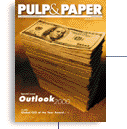| |

| FORECAST (000 tons) |
| U.S. |
2000e |
1999e |
1998 |
| Production1 |
24,850 |
25,144 |
24,622 |
| Capacity2 |
22,308 |
22,244 |
22,216 |
| Kraft |
806 |
715 |
727 |
| Recycled |
5,001 |
4,990 |
4,769 |
| Utilization rate (%) |
91 |
92.3 |
91.2 |
| Exports1 |
3,350 |
3,199 |
3,711 |
| Imports |
460 |
450 |
427 |
| U.S. consumption1 |
21,960 |
22,395 |
21,338 |
| lb/capital |
158.9 |
163.6 |
157.3 |
| 000 tons/billion $ |
2.86 |
2.99 |
2.91 |
real GDP/92-chain weighted
e=Pulp & Paper Week estimated |
| 1. AF&PA monthly statistics. 2. AF&PA capacity survey; includes 1.8 million tons of indefinitely shut capacity. |
| TOP N. AMERICAN PRODUCERS |
| Rank |
Company |
Annual capacity (000 mtons)1 |
Capacity share (%) |
| 1. |
Smurfit-Stone Container1 |
3,737 |
13.7 |
| 2. |
International Paper Co2 |
3,488 |
12.8 |
| 3. |
Georgia-Pacific Corp. |
2,631 |
9.6 |
| 4. |
Weyerhaeuser Co.3 |
2,596 |
9.5 |
| 5. |
Inland Paperboard |
2,155 |
7.9 |
| 6. |
Willamette Industries |
1,404 |
5.1 |
| 7. |
Packaging Corp America |
1,325 |
4.8 |
| 8. |
Gaylord Container |
1,320 |
4.8 |
| 9. |
Green Bay Packaging |
700 |
2.5 |
| 10. |
St. Laurent Paperboard |
606 |
2.2 |
Total U.S. capacity (1999): 27,234; (2000): 27,309
Capacity share of top five companies: 53.5%
Capacity share of top 10 companies: 73.1% |
| 1. Does not include the following indefinitely shut mills: 480,000 tpy Florida Coast Paper mill in Port St. Joe, Fla., the 360,000 tpy Port Westworth, Ga., mill, and the 355,000 tpy Jacksonville, Fla., kraft linerboard mill. 2. Does not include the 340,000 tpy Gardiner, Ore., linerboard mill, or the indefinitely shut 252,000 typ No. 6 machine at the Savannah, Ga., mill. 3. Includes 691,000 typ of capacity from newly acquired MacMillan Bloedel Ltd. mills. 4. Excludes Canadian mill. |
|
Linerboard prices jump to 3-year high; upturn expected to continue in 2000
GRADE STRUCTURE. Linerboard is used as the inner and outer portion of domestic corrugated containers. The board is made in a range of basis weights. Standard is 42-lb/1000 ft2. Other important weights are 33 lb, 34 to 37 lb, 55 to 61 lb and 69 lb. Production of recycled linerboard has grown rapidly in the last 10 years. In 1989, it represented 2% of total linerboard capacity. In 1999, it represented an estimated 18%. U.S. linerboard production in 1999 was on track to total 25.1 million tons, including 17.5 million tons of unbleached kraft linerboard, 4.2 million tons of recycled linerboard, and 3.2 million tons of exported linerboard .
CURRENT MARKET CONDITIONS. The U.S. linerboard market jumpstarted in the first quarter with a price increase that was driven by a reduction in the supply line. In an unprecedented move, producers at the end of 1998 planned to permanently shut 1.8 million tons of linerboard capacity annually, representing 6.6% of total U.S. linerboard capacity. In addition, demand for boxes stayed consistent and steady throughout 1999. Actual box shipments were on track to grow 1.4% in 1999 over the 1998 level and total 401.2 billion ft2.
With the reduced supply line, U.S. unbleached kraft linerboard prices turned around quickly in February/March 1999, following about nine months of price erosion. The 1998 yearend price was $335-$345/ton—its lowest level since the summer of 1997. The $50/ton increase in early 1999 raised prices for 42-lb kraft linerboard in the eastern U.S. to $385-$390/ton by March. Producers increased the linerboard prices again in July by $40/ton.
The solid domestic market was unaffected by a weak export market. Through October, U.S. kraft linerboard exports were down 15.8%, with October’s shipments of 204,300 tons the lowest one-month export shipment total in more than three years. The decline in exports was caused by the solid U.S. demand that drove several producers away from exports, and by the slow-growing economies in Asia, Europe, and Latin America. Still, U.S. producers increased export linerboard prices in the first half of the year in Asia and Latin America, and in the second half of the year in Europe.
SUPPLY/DEMAND. The U.S. corrugated market in 2000 should continue in an upturn. Analysts cite several reasons. They expect continuing solid U.S. economic growth (2.7% GDP in 2000), a significant turnaround in world economic growth driven by Asia and Europe (with global GDP increasing to 3.6% in 2000 from an estimated 3.1% in 1999), minimal new linerboard capacity in the U.S., the continued indefinite shut of U.S. linerboard capacity, and upward price pressure on U.S. linerboard from recovered paper materials.
Suppliers talked of a possible price increase on linerboard for the end of first quarter 2000 or in early second quarter. But producers were waiting to see how the supply line would be affected by possible Y2K stockpiling.
PRICES. U.S. linerboard prices were expected to increase at least once in 2000 because of consistent box demand, a reduced supply line, and an improved export market. The negatives that could impact the market include a Y2K-caused build in inventory in first quarter 2000, a U.S. recession (although analysts expect no U.S. recession in 2000 or 2001), a slowdown in Asia’s economic recovery including the devaluation of the Chinese currency, and a rapid startup of creep or indefinitely shut capacity. In 1999, the average price for U.S. unbleached kraft linerboard in the East was about $400/ton, up from $372/ton in 1998. Historical yearend transaction prices for 42-lb kraft linerboard in the eastern U.S. follow: 1999, $425; 1998, $340; 1997, $390; 1996, $355; 1995 $485; 1994, $430.
BY GREG RUDDER
Associate Editor

|




